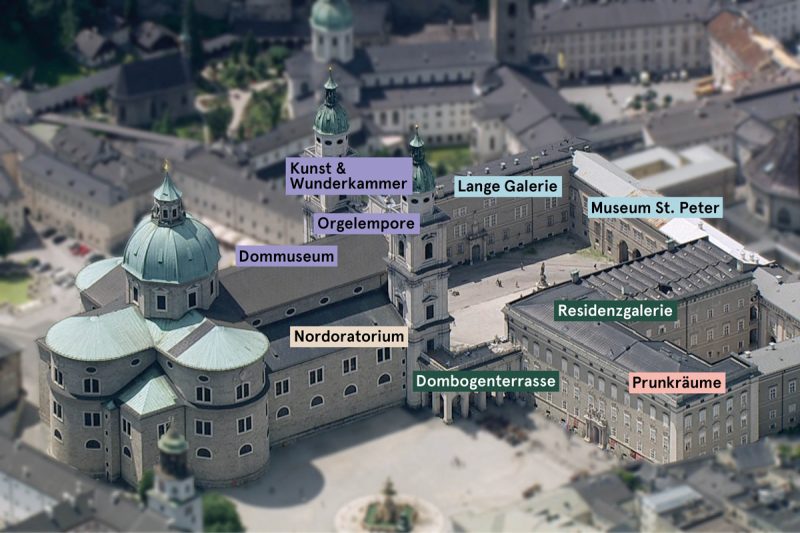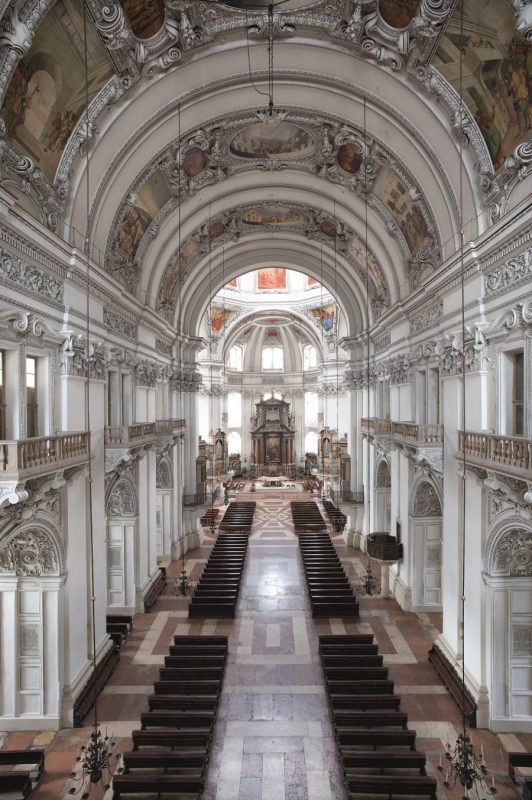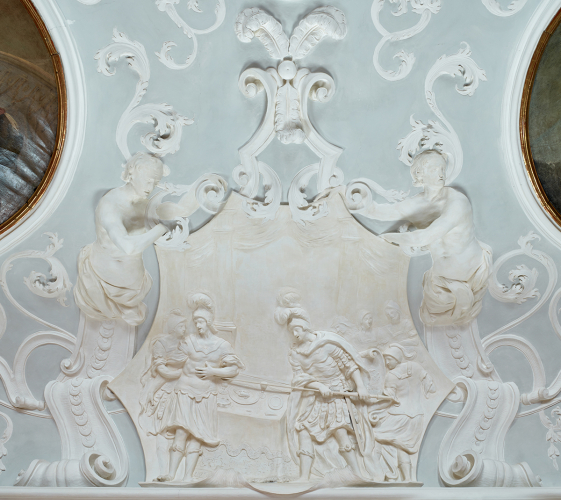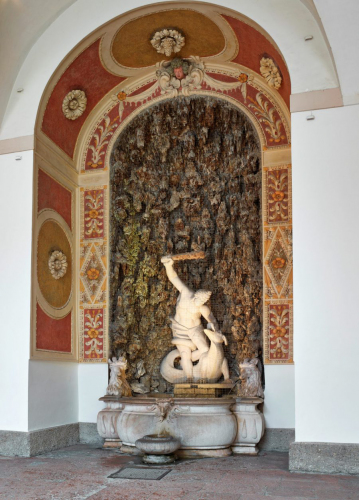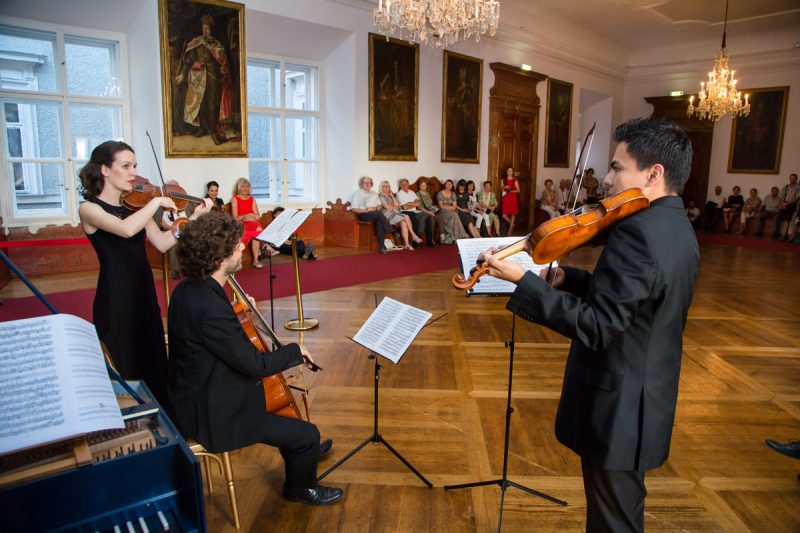The DomQuartier as the heart of Salzburg UNESCO World Heritage site
In 1972, the General Conference of UNESCO adopted the Recommendation concerning the Protection of the Cultural and National Heritage.
A heritage of all humankind
The World Heritage Convention developed from the awareness that over the whole word there are monuments, buildings and localities, the preservation of which is in the interest of entire humanity, since they represent unique testimonies to the history of humankind, nature and culture. In order to preserve them for future generations, in 1972 an instrument of international law was created as the basis for international collaboration to protect these sites: the World Heritage Convention.
Salzburg and Schönbrunn: the first World Heritage sites in Austria
In 1996, Austria celebrated its first entries in the list of World Heritage sites: since then, the historic centre of Salzburg and the Palace and Gardens of Schönbrunn have belonged officially to the heritage of humankind.
Not every locality can be a World Heritage site
UNESCO awards the World Heritage seal to sites that represent outstanding universal value. These are exceptional testimonies of past cultures, material traces of encounters and exchanges, artistic masterpieces or unique natural landscapes. UNESCO has defined ten criteria for nominating a site. Four of these describe the qualities of Cultural Heritage sites.
The exceptional universal value of Salzburg
Salzburg meets two of the criteria:
(ii) Salzburg played a central role in the interchange between Italian and German cultures, which enabled the flourishing of both cultures and a long-standing exchange between them.
(iv) Salzburg is an exceptionally important example of a European ecclesiastical city state, distinguished by a considerable number of outstanding and very well preserved secular and ecclesiastical buildings dating from epochs ranging from the late Middle Ages to the 20th century.
The DomQuartier as the heart of Salzburg’s World Heritage site
Today’s DomQuartier was the centre of this secular and ecclesiastical seat of power. It was also the domain of the man who brought an Italian ambience to Salzburg with magnificent buildings such as the Residenz, transforming the design of the town. Prince-Archbishop Wolf Dietrich von Raitenau spent much of his youth in Rome where, under the wing of his uncle, the powerful Cardinal Altemps, he learned to appreciate the sensuous magnificence of Roman baroque. Hardly had he taken office than he began to reshape the centre of his residence town, inviting Italian architects and artists of all kinds to Salzburg. With Andrea Bertoletto, he started on the New Residenz (which now houses Salzburg Museum).
From then on, a whole series of stonemasons – the magistri comacini – arrived from Lake Como to work in Salzburg. From 1597, with court architect Elia Castello, Wolf Dietrich set about altering and redesigning the Residenz. To make room for this, he purchased neighbouring houses and had them demolished.
The work was considerably influenced by the successor to the famous Andrea Palladio, Vicenzo Scamozzi, who also planned for Wolf Dietrich a new cathedral which, however, was never built. After a fire in the Romanesque cathedral in 1598, and failed attempts at reconstruction, Wolf Dietrich ordered the demolition of the ruins and surrounding buildings, including parts of the cathedral monastery on the Kapitelplatz, in order to make room for a new cathedral – which was then built, not by Scamozzi, but under Wolf Dietrich’s successor Prince-Archbishop Marcus Sitticus, by Santino Solari to his own design and slightly smaller.
Collaboration with Italian artists continued under Marcus Sitticus and Paris Lodron, during whose period of office the new Cathedral was completed (apart from the two west towers) and consecrated. The reconstructed Residenz was Italianate not only in style, but also in the structure, which brought a southern ambience to Salzburg. Wolf Dietrich’s pleasure garden, called “Dietrichsruh”, started in 1605, was designed as a private courtyard with fountains, statues, grottos, a bird-house and a sala terrena, following Italian examples. Modernisation carried out later, under Prince-Archbishop Franz Anton Harrach, was designed by Italian artists, who were highly rated: Antonio Beduzzi and Alberto Camesina worked alongside Johann Michael Rottmayr and Martino Altomonte.
Intangible values in the DomQuartier
(vi) Salzburg is noteworthy for its association with the arts, in particular with music, in the person of its famous son Wolfgang Amadeus Mozart.
Inscription criteria for intangible values include preserved buildings which represent direct testimonies – such as the Cathedral and the Residenz to the life and works of Mozart, who wrote compositions for these places and himself performed there. He appreciated the variety of occasions for which he was commissioned to provide the music. The rooms themselves have been maintained with such authenticity that they still have the acoustics of Mozart’s era.
Wolf Dietrich’s reorganisation of the court and Cathedral music made Salzburg an important and innovative musical hub in Europe. Indeed, the first opera performance north of the Alps – Claudio Monteverdi ‘s Orfeo – was given here.
Select musical performances in this tradition are still held in the DomQuartier: Musikereignisse im DomQuartier.
New World Heritage centre in the Mirabell Garden
From 2025, a new museum in the south wing of the historic Orangery in the Mirabell Garden will house an exhibition space devoted to Salzburg’s Old Town as a UNESCO World Heritage site. A comprehensive display will be presented as Orangery Salzburg – Panorama Museum / World Heritage Centre.
UNESCO
UNESCO is the United Nations Educational, Scientific and Cultural Organisation. There are currently 194 member states. UNESCO was founded to promote international co-operation in these areas, thereby contributing to peace and security. UNESCO placed emphasis on the forward-looking inclusion of civil society in intergovernmental co-operation, so that national commissions were established to support their governments through professional expertise. The Austrian UNESCO Commission (ÖUK) was founded in 1949 as a national liaison and co-ordination office of the UNESCO constitution.
International Council on Monuments and Sites (ICOMOS)
ICOMOS is an international non-governmental organisation comprising professionals, experts, representatives from local authorities , companies and heritage organisations, and is dedicated to the conservation and enhancement of the architectural and landscape heritage throughout the world. ICOMOS is an advisory body of the World Heritage Committee for the implementation of the World Heritage Convention of UNESCO. There are national committees in more than 120 countries, including Austria.
The World Heritage representative of Salzburg co-ordinates all agendas relating to World Heritage.
Weiterführende Links:
World Heritage explained – animated short about the UNESCO World Heritage Convention
UNESCO-Welterbe – Historic centre of the city of Salzburg
Orangerie Salzburg – Panorama Museum / World Heritage Center
UNESCO – United Nations Educational, Scientific and Cultural Organization
Austrian Commission for UNESCO
ICOMOS Austria – Austrian national komitee
World Heritage Commissioner of the City of SalzburgWelterbebeauftragter der Stadt Salzburg

